The lightning-fast evolution of the AI landscape makes it a challenge for IT to integrate new AI systems and use cases into existing infrastructure. Our research provides a foundational framework to help you select the right architectural components for your AI solutions. Build an AI architecture that is flexible enough to handle the ever-changing demands of AI, scales up to the demands of the organization, and ensures your AI architecture is set up for success.
Though organizations have embraced the potential of AI to deliver transformational solutions, they must be cognizant of their unique problems and needs, or risk poor or improper implementation that would be harmful and costly to fix. When deciding what AI solutions to build or buy, organizations must relate that choice back to the kind of architecture that would be needed to support them and ensure each stage of building that architecture is given due care.
1. Don’t build it all in one piece.
Rather than treating their AI platform as a monolith requiring major overhauls with each new implementation, architects must think of the system in terms of its individual building blocks and the way they relate to each other. The result will be an adaptable platform that scales easily and allows seamless integration of components as new use cases arise.
2. AI is not always the answer.
Though AI is often presented as an all-encompassing revolution, the truth is that not all problems require an AI solution. First determine how the AI use case will generate organizational value before committing to full-scale implementation.
3. Take the time to do it right.
AI implementation can be a complex undertaking – rushing any part of it raises the risk of costly mistakes. Plan to build your target state architecture in phases, with clear milestones and regular check-ins on your AI system, using KPIs like model accuracy, deployment success rates, and system uptime.
Member Testimonials
After each Info-Tech experience, we ask our members to quantify the real-time savings, monetary impact, and project improvements our research helped them achieve. See our top member experiences for this blueprint and what our clients have to say.
9.0/10
Overall Impact
$1,169,999
Average $ Saved
68
Average Days Saved
Client
Experience
Impact
$ Saved
Days Saved
Christian Healthcare Ministries, Inc.
Guided Implementation
8/10
N/A
26
Christian Healthcare Ministries, Inc.
Guided Implementation
10/10
$1.17M
110
Best part - Irena was knowledgeable & helpful, just the advise to "devise an AI use case" has the potential to save our company from cyber-attacks ... Read More
Define the Components of Your AI Architecture
Set up the foundation of your AI architecture for success.
Analyst Perspective
The rapid pace of AI innovation necessitates building systems that can adapt and evolve over time.
Irina Sedenko
Technical Counselor
Info-Tech Research Group

Ibrahim Abdel-Kader
Senior Research Analyst
Info-Tech Research Group
Rapid technological advancements have increased the complexity of AI systems. But these advancements have also enabled new use cases and applications of AI with the introduction of new AI frameworks, design patterns, and model types used by systems. To leverage those new opportunities, it is important to continuously evolve best practices for designing AI systems.
When done correctly, AI architecture is not a monolithic technology stack that requires major modifications for a new implementation, but rather a flexible and scalable platform that allows seamless integration of the components required for a new system or a new business use case.
Understanding the building blocks and the dependencies of the components involved is crucial, since they form the backbone of every AI platform implementation. Do not blindly chase the hype! Learn what it takes to build solutions properly, so you don’t get stuck with costly fixes that act as temporarily pain relief.
Review considerations before buying or building solutions from scratch. Every decision matters! Our research and experts will help you navigate the increasing complexities and gain the confidence to scale the effectiveness of AI architectures powered by systems and models that require these architectures to handle computationally intensive AI applications and massive data sets and run real-time inference.
Executive Summary
Your ChallengeYour organization is increasing its reliance on AI to deliver exponential value to its staff and customers. You are noticing several challenges:
| Common ObstaclesOrganizational success is hindered as AI solutions fail to deliver. Your organization lacks:
| Info-Tech’s ApproachEnsure that your AI architecture provides value to your organization at scale:
|
Info-Tech Insight
Build your target state architecture from predefined best-practice building blocks. An AI platform is not a monolithic technology stack that requires major modifications for a new implementation, but rather a flexible and scalable platform that allows seamless integration of the components required for new use cases.
Key Concepts
AI Lifecycle
The AI lifecycle includes all events and processes that relate to an AI system’s life span from inception to decommissioning, including its design, research, training, development, deployment integration, operation, maintenance, sale, use, and governance.1
Data Sources
Data sources are the origins of the data used for analysis, modeling, and decision-making in AI solutions. They can include structured data from databases, unstructured data from text documents, and real-time data from sensors and IoT devices.
Data Engineering Engine
A data engineering engine automates the processes of collecting, transforming, and preparing data for analysis and machine learning, ensuring that data is clean, reliable, and ready for use in AI models. It integrates various data sources and applies data processing techniques to support the development and deployment of AI solutions.
Data Science and Model Development
Data science includes a broad grouping of mathematics, statistics, probability, computing, and data visualization used to extract knowledge from a heterogeneous set of data (images, sound, text, genomic data, social network links, physical measurements, etc.).2 Model development consists of processes to ensure that various principles are met and ready for deployment in accordance with AI solution objectives.
Infrastructure
Infrastructure includes foundational physical and virtual resources, such as servers, storage, networking, and software, that are necessary to support the development, deployment, and operation of AI solutions. It ensures that the AI system has the necessary capabilities to function effectively and efficiently.
Data Platform
A data platform supports the collection, storage, processing, and analysis of data, enabling organizations to manage and use their data assets effectively. It integrates various data sources and tools to provide a unified environment for data-driven decision-making.
Sources: 1. GOV.UK, 2024; 2. Council of Europe, 2021
AI fails to deliver success
Avoid contributing to this trend.
80%
… of AI projects fail, which is twice the failure rate of non-AI-related start-ups.
60%
… of AI projects fail due to misalignment of goals between key stakeholders and the technical team.
55%
… of AI projects fail due to poorly prepared data sets.
50%
… of models are delivered of what they could have been due to leaders directing the team to move on from projects prematurely.
14%
… of organizations are fully ready to integrate AI into their businesses.
Source: RAND, 2024
Launch your AI proof of concept
“We need to launch an AI proof of value to assess the viability of the technology before we invest.”
ChallengesLeaders need to show that AI initiatives can work as intended and will yield tangible business benefits.
Assessments face significant time constraints.
If the project team takes too long to secure support, this could lead to funding delays or missed opportunities.
This research is focused on these steps.
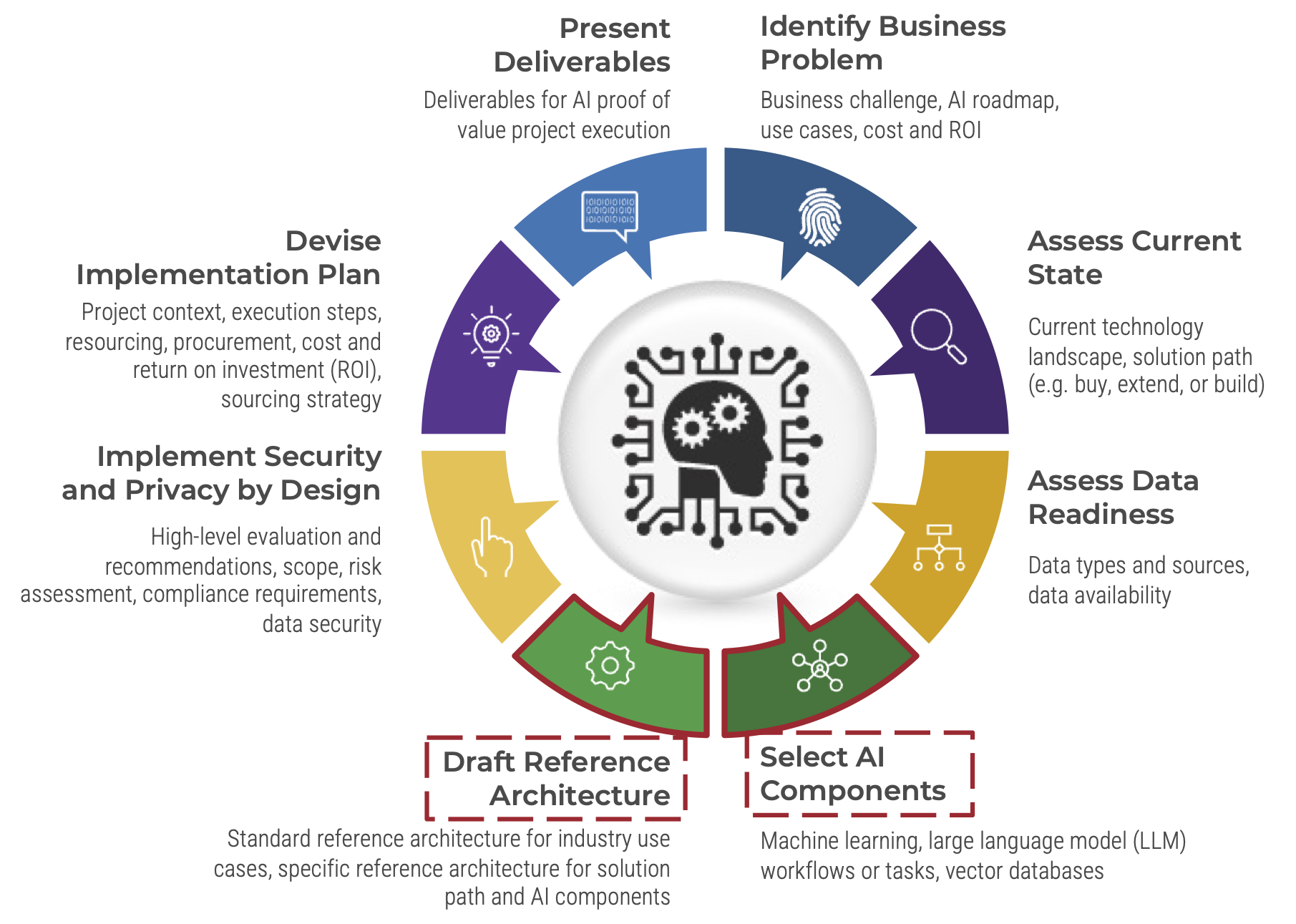
Adopt a formal methodology to accelerate AI vendor selection and improve outcomes.
ResultsIdentify relevant capabilities to support the AI use cases you identified.
Validate AI use cases against business requirements.
Identify vendors to support AI use cases, devise a vendor selection model, and select products for review.
Every successful AI architecture goes through a journey
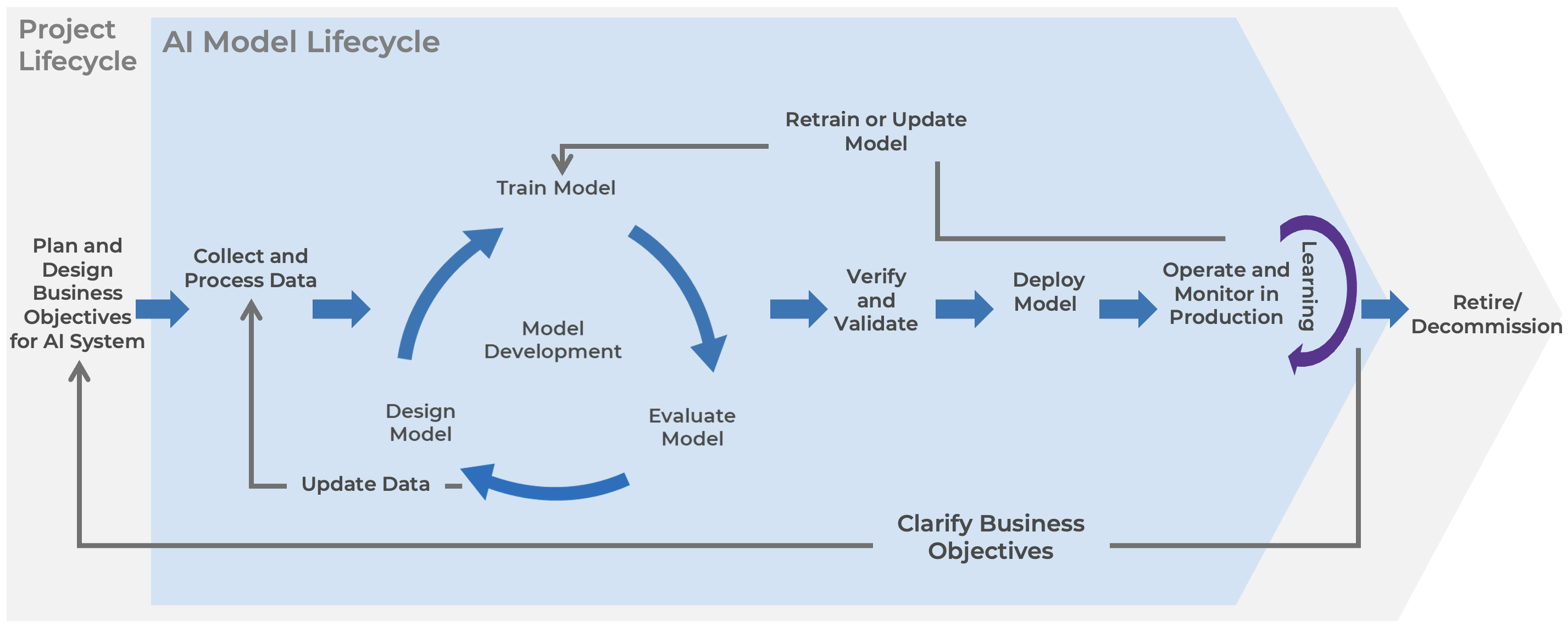
AI Lifecycle Stages: Potential AI Risks and Activities
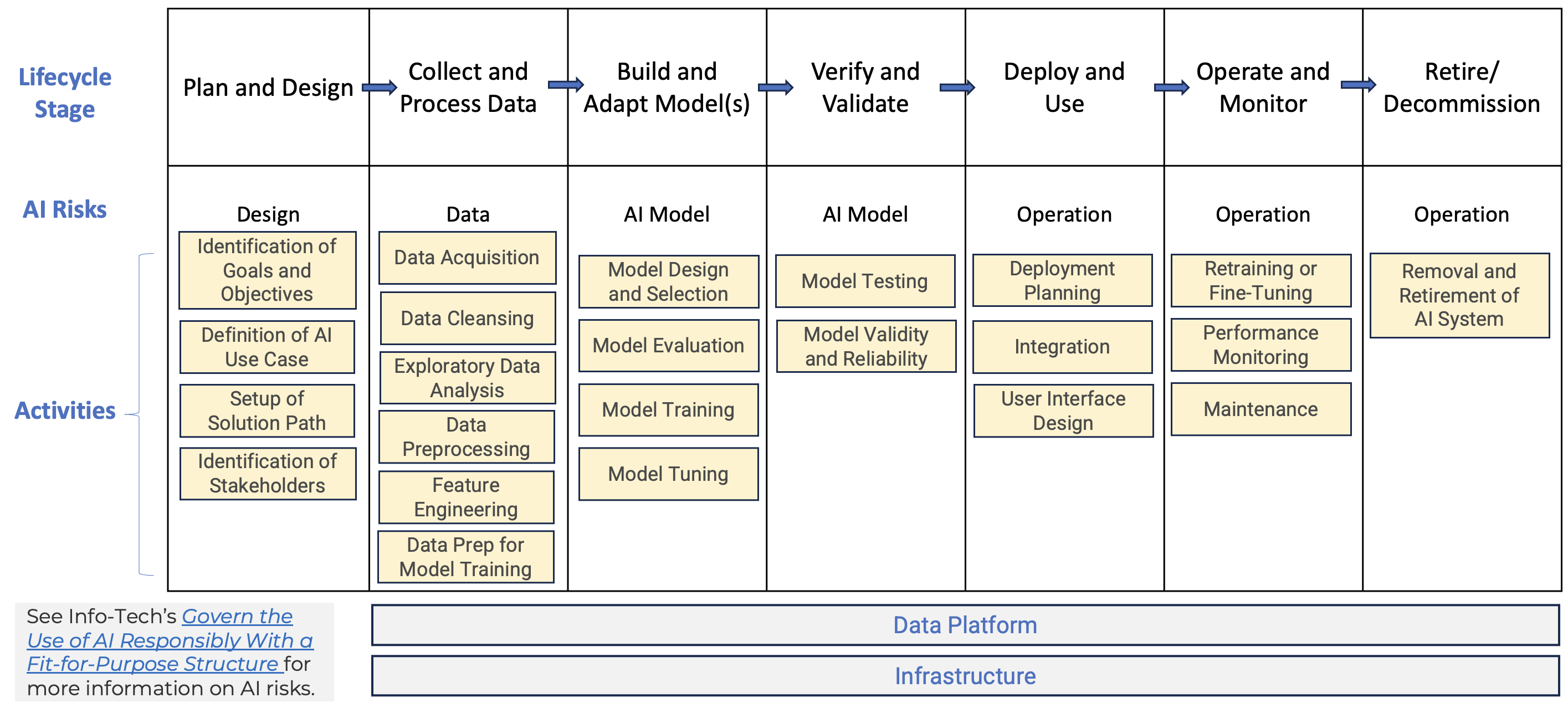
See Info-Tech’s Govern the Use of AI Responsibly With a Fit-for-Purpose Structure for more information on AI risks
Source: Based on National Institute of Standards and Technology (NIST), 2023
It’s imperative to understand the building blocks of your AI architecture
AI Reference Architecture: High Level
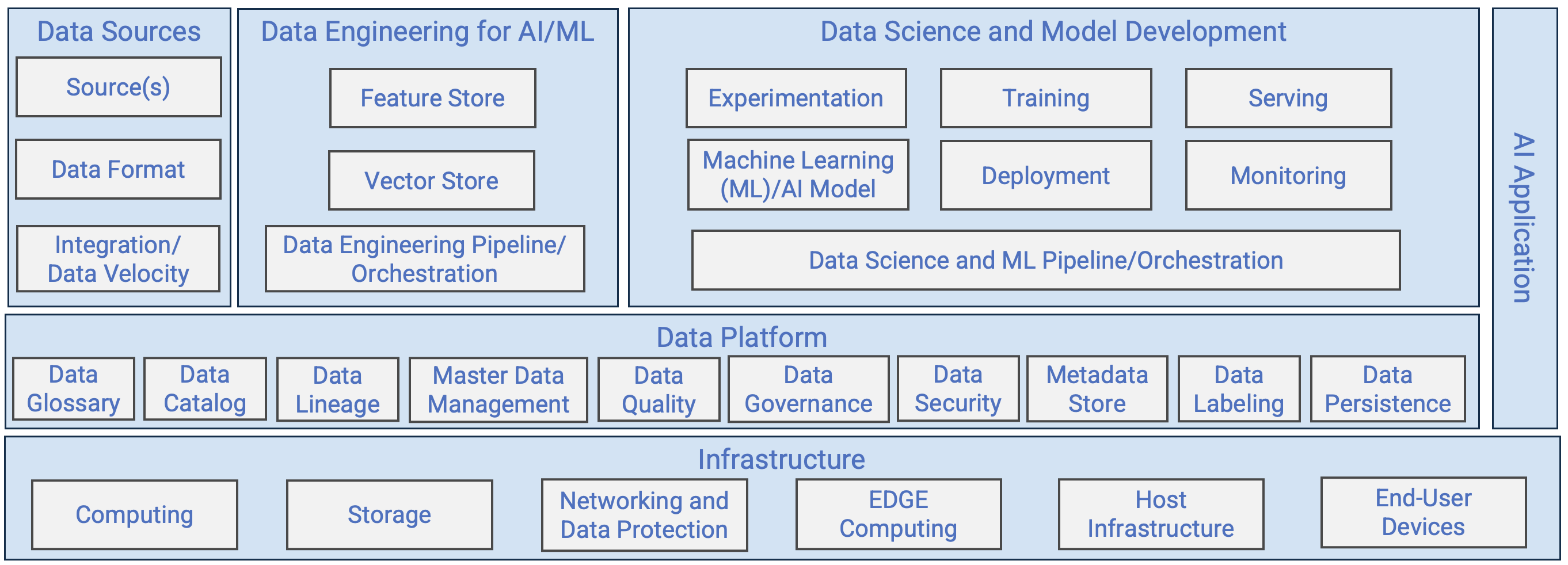
Select the right components to fully optimize your AI architecture
AI Reference Architecture: Detailed
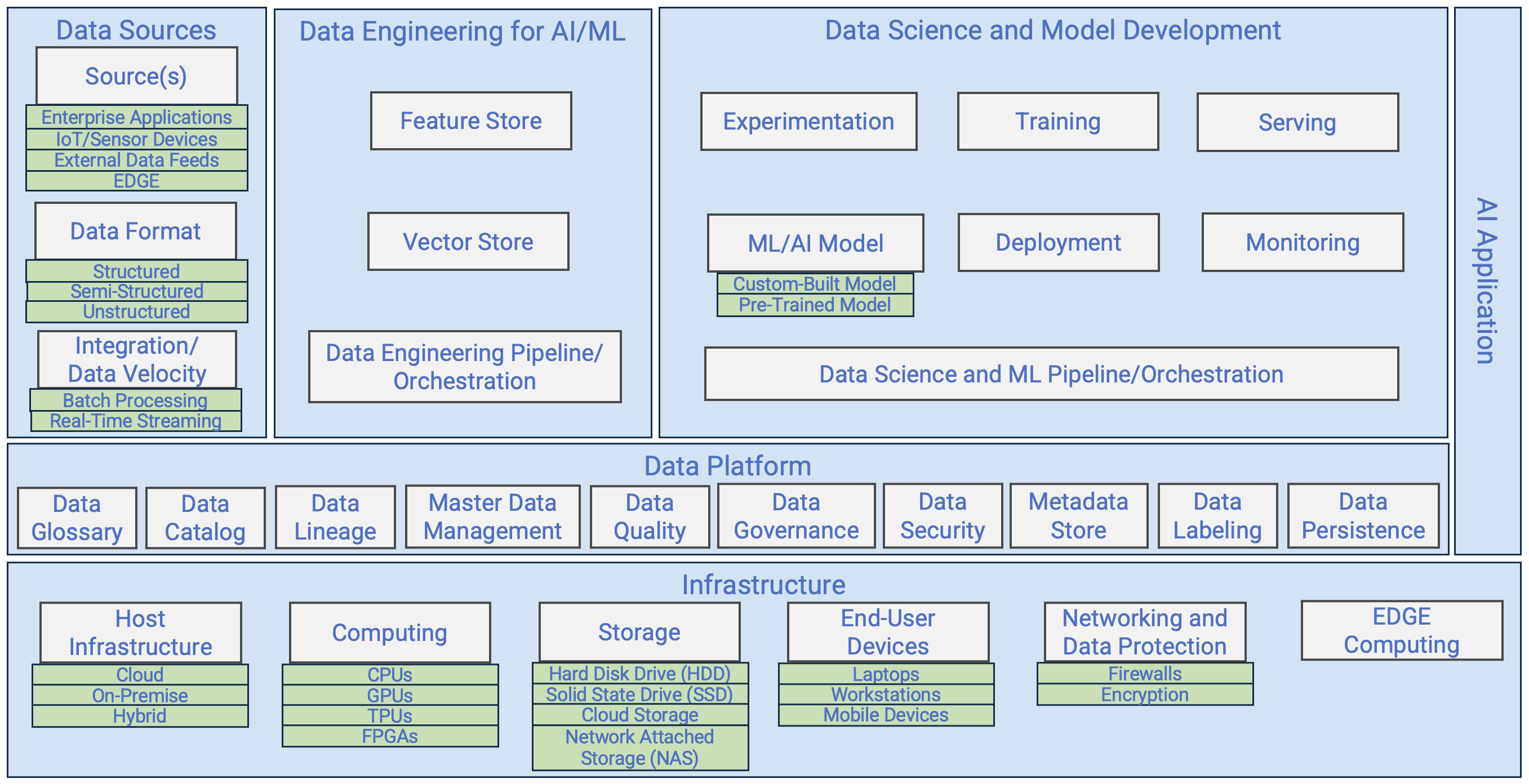
Choose the AI solution path that will lead to success

Consider these phases as you buy and configure your AI architecture
AI Lifecycle and Reference Architecture Alignment – Buy and Configure
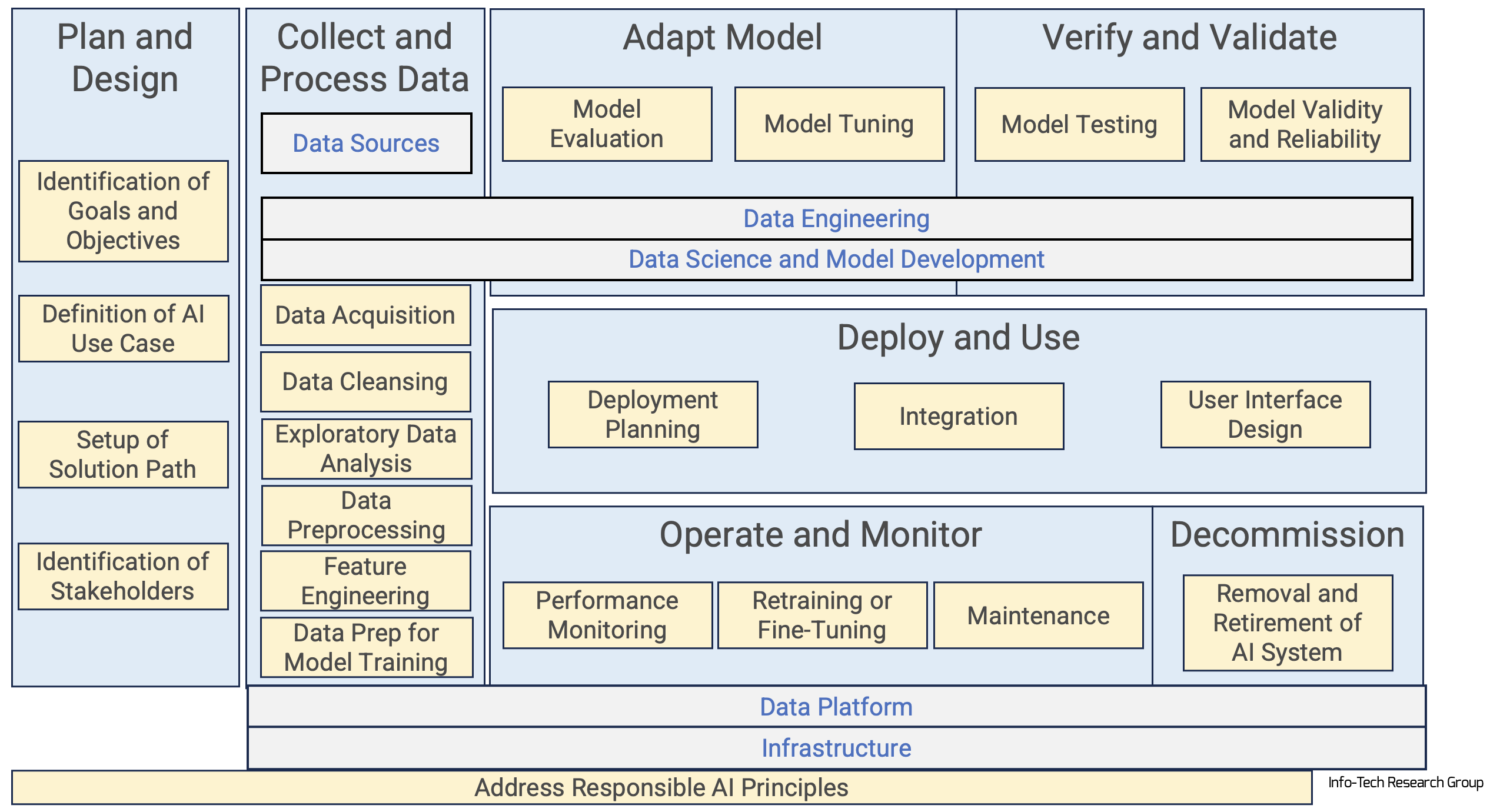
Consider these phases as you build your AI architecture
AI Lifecycle and Reference Architecture Alignment – Build
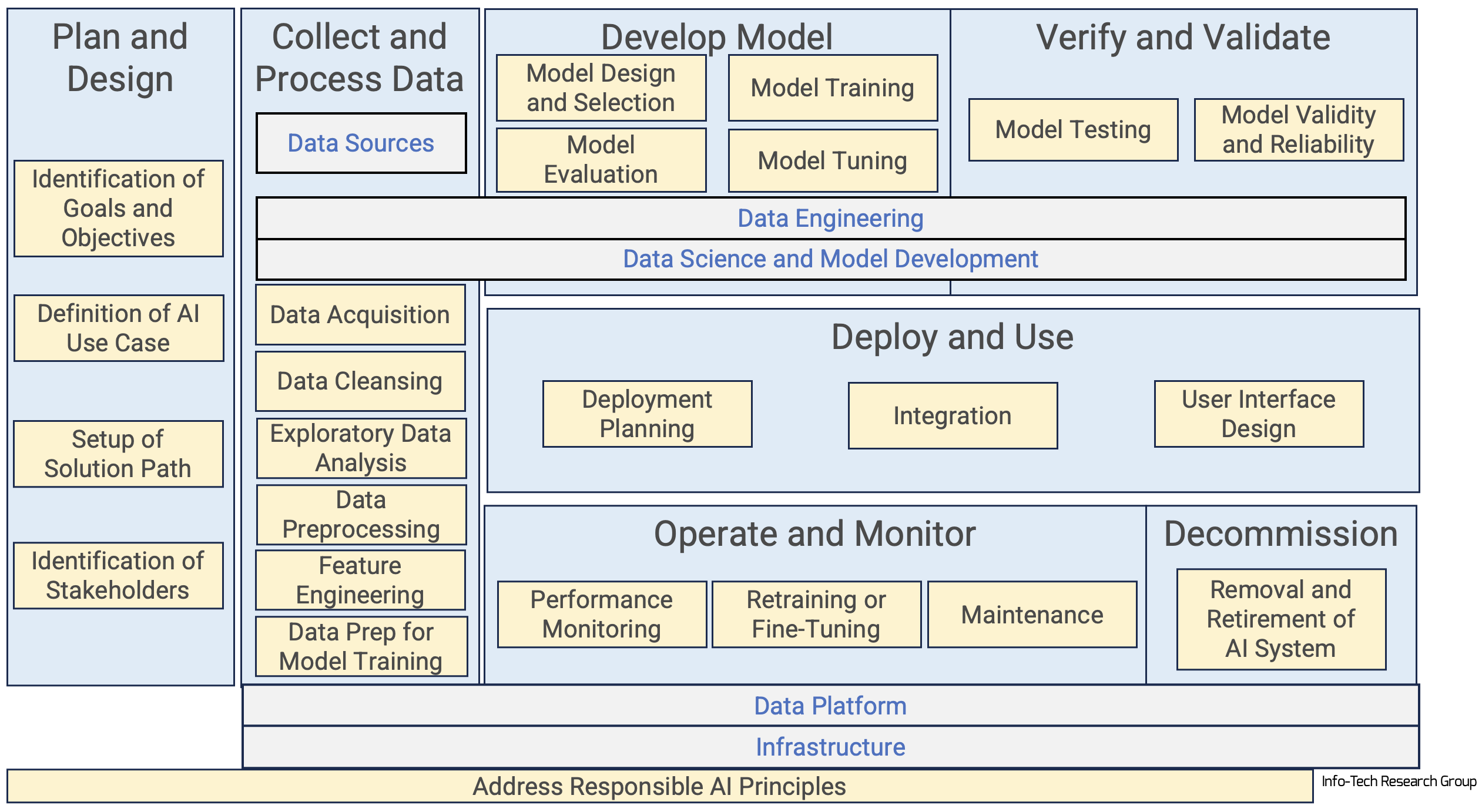
Define the Components of Your AI Architecture: Project Overview
Define the Components of Your AI Architecture
Best-Practice Toolkit- Plan and design AI use cases.
- Select AI components.
- Draft your reference architecture.
Guided Implementations
Call 1 – Identify your goals and objectives.
Call 2 – Document AI use cases.
Call 3 – Set a solution path.
Call 4 – Identify stakeholders.
Call 5 – Review the considerations for each AI component.
Call 6 – Select the AI components of your architecture.
Call 7 – Draft a reference architecture.
Call 8 – Document high-level workflows and implications.
Outcome
Definition of AI architecture scope with use cases and a solution path that includes:- AI business goals and objectives.
- Value proposition and expected outcomes of each AI use case.
- Decision to buy capabilities to support each AI use case, build new capabilities from scratch, or extend existing capabilities to support the AI use case.
- Members of the AI project team.
Decision on components that enable AI architecture by:
- Further defining each AI use case with architecture considerations.
- Selecting the components for the AI architecture.
Overview of how AI reference architecture and use case summaries lead to successful organization outcomes, including:
- Initial AI reference architecture.
- Documentation of high-level workflows and implications.
Insight Summary
Overarching Insight
Build your target state architecture from predefined best-practice building blocks. An AI platform is not a monolithic technology stack that requires major modifications for a new implementation, but rather a flexible and scalable platform that allows seamless integration of the components require cases.
Use Case Insight
Not all business use cases require AI to improve business capabilities.
Determine how the AI use case will generate business value before you commit to a full-scale implementation.
Solution Path Insight
Knowing the AI solution path that you want to use will simplify the architecture considerations.
Building Blocks Insight
Recognizing the fundamental building blocks and their interdependencies is essential for any AI platform implementation.
By mastering these core elements, you can effectively design any type of AI architecture and prevent costly mistakes.
Tactical Insight
To achieve many successful AI implementations, plan your target state architecture with clear milestones and deliver it in phases, implement robust model versioning and deployment management practices, and continuously monitor the AI system in production using key performance indicators (KPIs) such as model accuracy, deployment success rates, and system uptime.
Blueprint Deliverables
Each step of this blueprint is accompanied by supporting deliverables to help you accomplish your goals.
AI Architecture Component Selection Tool
Use this tool to help support the selection of AI components associated with the architecture design.
Key Deliverable
AI Architecture Executive Presentation Template
Use this template to help you build a clear and compelling case for an AI architecture design that you can present to executive management and sponsors.
Benefits of a component-based approach
IT Benefits
- Simplifies the process of architecture creation, since it provides a layered approach to hide or expose details
- Provides a modeling framework that allows you to describe, visualize, and analyze your business structure in a defined and controlled manner
- Gives a roadmap earmarked by relatively stable states when certain capabilities can be implemented
- Includes research on standard AI architecture patterns, which reduces the need for custom research
Business Benefits
- Identifies required business capabilities that will be fulfilled by AI
- Validates business capabilities that provide information on the return and viability of given current architecture
- Provides insight on the roles, responsibilities, and timelines for different groups developing the AI-based capabilities
- Saves time by building AI architecture from tried and tested architecture building blocks
- Gives sooner insight into the success of an AI project
Measure the value of this blueprint
- Increase the number of entities in the platform that support AI.
- Measure progress by the attainment of architecture plateaus as defined in your roadmap.
- Measure the time that data scientists have to spend wrangling data.
The more success indicators that are met, the better equipped your AI program is to scale the architecture and handle complexity.

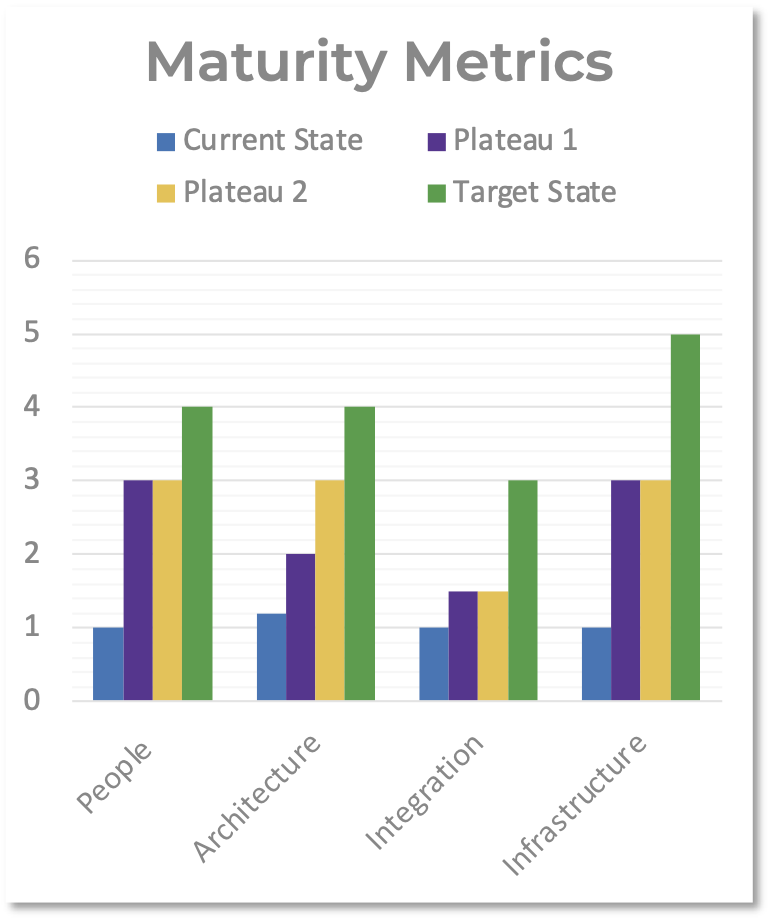
Establish Baseline Metrics
Baseline metrics will be improved through:
- Improving AI implementation and AI lifecycle practices.
- Planning the target state architecture and delivering it in phases.
- Putting management practices in place for model versioning and model/system deployment.
- Monitoring the AI system in production.
Metric | Current | Goal |
| Monthly cost of the AI program | US$1M | US$0.75M |
| Number of building blocks reused in each project | 0 | 10 |
| Number of quality assurance (QA) incidents logged per month for AI models | 10 | 5 |
| Number of sources available on the data platform that have required quality assessment | 5 | 15 |
| Time needed to implement a new AI use case (months) | 10 | 2 |
| Time spent by scientists on non-modeling tasks (hours/month) | 120 | 40 |
Phase 1
Define the Components of Your AI Architecture
Phase 1
1.1 Plan and design AI use cases.
1.2 Select AI components.
1.3 Draft your reference architecture.
This phase will walk you through the following activities:
- Identify goals and objectives.
- Document AI use cases.
- Set a solution path.
- Identify stakeholders.
- Review the considerations for each AI component.
- Select the components of your AI architecture.
- Draft your reference architecture.
- Document high-level workflows and implications.
Define the Components of Your AI Architecture
This phase involves the following participants:
- IT leader
- Technical IT lead
- Business analyst
- Business lead
- Process expert


 Establish an Analytics Operating Model
Establish an Analytics Operating Model
 Create and Manage Enterprise Data Models
Create and Manage Enterprise Data Models
 Build a Robust and Comprehensive Data Strategy
Build a Robust and Comprehensive Data Strategy
 Mandate Data Valuation Before It’s Mandated
Mandate Data Valuation Before It’s Mandated
 Position and Agree on ROI to Maximize the Impact of Data and Analytics
Position and Agree on ROI to Maximize the Impact of Data and Analytics
 Establish the Target Operating Model Needed to Execute Your Data Strategy
Establish the Target Operating Model Needed to Execute Your Data Strategy
 Establish Data Governance
Establish Data Governance
 Build a Data Architecture Roadmap
Build a Data Architecture Roadmap
 Build a Data Integration Strategy
Build a Data Integration Strategy
 Build a Data Pipeline for Reporting and Analytics
Build a Data Pipeline for Reporting and Analytics
 Build Your Data Quality Program
Build Your Data Quality Program
 Mitigate Machine Bias
Mitigate Machine Bias
 Design Data-as-a-Service
Design Data-as-a-Service
 Define the Components of Your AI Architecture
Define the Components of Your AI Architecture
 Get Started With Artificial Intelligence
Get Started With Artificial Intelligence
 Go the Extra Mile With Blockchain
Go the Extra Mile With Blockchain
 Understand the Data and Analytics Landscape
Understand the Data and Analytics Landscape
 Select Your Data Platform
Select Your Data Platform
 Build Your Data Practice and Platform
Build Your Data Practice and Platform
 Establish Data Governance – APAC Edition
Establish Data Governance – APAC Edition
 Foster Data-Driven Culture With Data Literacy
Foster Data-Driven Culture With Data Literacy
 Generative AI: Market Primer
Generative AI: Market Primer
 Establish Effective Data Stewardship
Establish Effective Data Stewardship
 Identify and Build the Data & Analytics Skills Your Organization Needs
Identify and Build the Data & Analytics Skills Your Organization Needs
 Promote Data Literacy in Your Organization
Promote Data Literacy in Your Organization
 Define a Data Practice Strategy to Power an Autonomous Enterprise
Define a Data Practice Strategy to Power an Autonomous Enterprise
 Data Culture Diagnostic
Data Culture Diagnostic
 Fueling AI Greatness: The Critical Role of Data & AI Literacy
Fueling AI Greatness: The Critical Role of Data & AI Literacy
 Building the Road to Governing Digital Intelligence
Building the Road to Governing Digital Intelligence
 Map Your Data Journey
Map Your Data Journey
 Launch a Customer-Centric Data-as-a-Product Journey
Launch a Customer-Centric Data-as-a-Product Journey